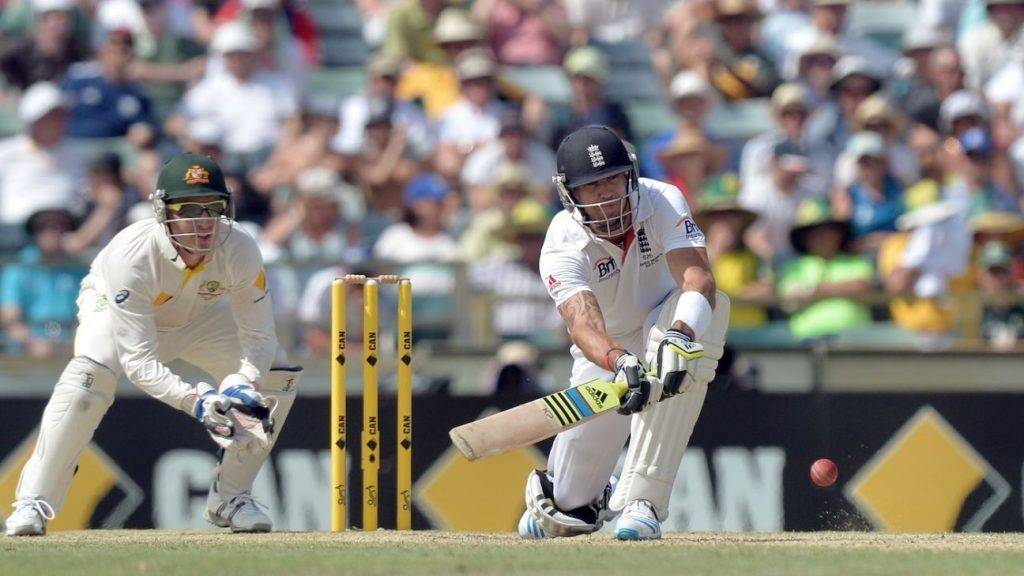Cliff Notes – Kevin Pietersen, match turner
- In extreme heat during the 2013 Test at WACA, Pietersen’s aggressive batting style was crucial, showcasing his ability to change the game’s momentum despite challenging conditions.
- His unique approach against fast bowlers, particularly Brett Lee, highlighted his willingness to take risks, which resulted in both remarkable successes and notable failures throughout his career.
- Pietersen’s strategy often involved attacking spinners to tire out quick bowlers, reflecting his understanding of game theory and the balance between risk and reward in high-pressure situations.
Kevin Pietersen, match turner – ESPN
In December 2013, when covering a Test at the WACA, journalists started putting their laptops in the fridge as they overheated. It was hot every day of this Test, with 37°C the maximum temperature. The sort of heat that melts your soul after a day or two.
Some batters say that it gets harder to think in hot conditions. They resort to trying to get as many runs as they can before fatigue gets them out. This was one of those days. England were well behind in the Test, needing to score 504 to win. At the crease was Kevin Pietersen.
The chances of winning were low. The heat had split the WACA pitch like a fault line, with cracks everywhere. Australia had Mitchell Johnson in peak form, and burly chested fast bowler Ryan Harris, who was almost as good. They were both too fast, too much. With a big total to chase, the wicket and the heat, nothing was on England’s side. But they did still have Pietersen, the player who changed things with his strokeplay. His strike rate at the end of his career was 62, which was nowhere near some of the quickest players. But when he went hard, it was violent. “Kevin Pietersen, he’s the best player I’ve ever seen play for England,” says David “Bumble” Lloyd.
At The Oval in 2005, Pietersen was yet to make a Test hundred. He was facing Brett Lee and Shaun Tait – two of the fastest bowlers, then and now. As well as Glenn McGrath and Shane Warne – two of the best bowlers, then and now.
Pietersen slog-swept Warne like he was a part-timer in a village team. The champion legspinner took 40 wickets in that series. Pietersen brought his hundred up from 124 balls, though for a period Warne bowled defensively around the wicket into the footmarks just to slow him down.
But it was the attack on Brett Lee that was the most exhilarating. After 60 balls, Pietersen was on 35, and most of those were boundaries from attacking Warne. Lee decided to bounce Pietersen.
It started with a bruise, clocked at 93.7mph. All Pietersen could do was glove it and almost fall over into his stumps. Straight after that, Lee went all in on the short ball. Pietersen went on the hook.
The second ball of this plan was hooked for six. Lee’s speed was 91mph. It cleared fine leg by some distance. Pietersen was not a great hooker; like many other tall batters, he didn’t face as many short balls growing up as others. He often made the decision late, and it was more of a panicked swipe. He also often tried to play it off the front foot, which he was even worse at. He averaged far less on the pull and hook than the top six batters of his era.
Pietersen used this shot differently compared to other players. He was daring quicks to keep bowling it to him. Lee did. Looking back, it felt like this contest went on forever. Lee kept getting faster and shorter, and Pietersen swung more and more frantically. Lee was forced to give up the plan.
No one who saw that innings live has ever forgotten it.
Pietersen was no one’s idea of a perfect batter. His technique involved hitting balls on the up, dragging deliveries from outside off to leg, and hitting the ball in the air. Playing across the line might have been why he struggled in the second innings of matches, averaging only 38, as the ball kept lower. Overall, the risks he took stopped him from averaging 50 in what was a great era to bat.
He is not an automatic selection for the top 50 Test batters of all time, but his ability to turn a match in an innings was like few others in history. It means his average of 47 is more significant than others.
About eight years after 2005, Pietersen is facing fast bowling from Australians again – this time on a faster wicket, at the WACA. But he is also going up against a new Australian spinner, Nathan Lyon, bowling with the breeze.
Australia have attacking fielders and boundary riders, an in-out field. Many batters would simply rotate the strike, punish any bad deliveries and keep their wicket intact. Lyon is the bowler to milk, to stay in against, to save your real energy for Johnson’s thunderbolts or Harris’ Mack Truck-like force. However, it is hot, and the Australian quicks are all rotating through their second spells. To give them more time to rest, Lyon’s offspin is floating on the breeze.
Pietersen starts to attack him almost immediately, smashing one back, which is stopped. Next, he comes down the wicket and drop-kicks a shot over mid- on. He gets three. The next over, there are two more boundaries: one from a fine sweep and another from a cover drive against the spin. Lyon stays on, and Pietersen wants to emphasise that he should not. So he runs down and smashes the ball over the long-on fielder into the crowd. It is audacious, wild, and exactly how Pietersen thinks.
He was averaging more than 50 against Lyon then. He has the match-up, has put him in the crowd, and scores off him with ease. One more blow will change Australia’s rest strategy.
Cover of The Art of Batting Bloomsbury
Pietersen runs down the wicket at Lyon one more time and goes for glory. But something doesn’t work; his head isn’t perfect, the ball doesn’t come from the middle, it hangs in the famous Fremantle Doctor and the catch is taken by Harris, one of the quick bowlers he is trying to tire, at long-on.
Though we were almost a decade into Pietersen’s career at this point, and he’d taken that sort of risk so many times, he was still taken to task for it.
People saw it as arrogance, a lack of patience, or just plain stupidity. But there was solid thinking to how he played. If he did knock Lyon out of the attack, Johnson would probably have to come back too early. Getting him tired was the key to making runs against Australia if you’d managed to survive Harris and the new ball.
Johnson and Harris were the threats. You could try handling them for hours and do that over time, or you could speed up the process by making the player who rests them unbowlable.
Pietersen often chose the faster, more dramatic option. And when it worked, England won the 2005 Ashes due to his 158 at the Oval. When it didn’t, Australia won the 2013-14 Ashes at the WACA. In terms of game theory, Pietersen was risk and reward. He was hailed as a hero when it worked and abused as a pariah when it didn’t.
This is a lightly edited extract from The Art of Batting: the Craft of cricket‘s Greatest Run Scorers, by Jarrod Kimber, Bloomsbury Sport, 2025


